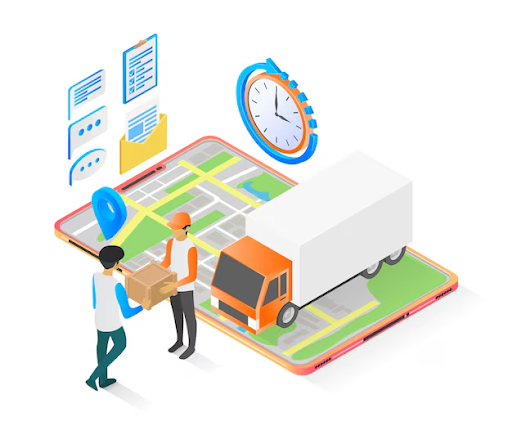Imagine being able to track your shipment in real-time through every stage and knowing exactly which stage your goods are at in the supply chain. Thanks to that, many difficult issues in the goods transportation process will be resolved. From optimizing operations, improving performance, to enhancing customer satisfaction..., all will be addressed thanks to real-time tracking and ETA features in supply chain management.
This article will explore the impact of real-time tracking and ETA on the logistics industry and how they contribute to customer satisfaction.
1. What is real-time tracking? Why are they important?
Real-time tracking means continuously monitoring shipments using GPS tracking devices and advanced software. This helps freight forwarding companies and their customers receive immediate updates on the location of the goods, the condition of the goods, and how the goods are moving.
Unlike old methods that only provide occasional updates, real-time tracking offers immediate insights into the entire journey of the goods.
Real-time tracking allows freight forwarding companies to continuously monitor shipments at every stage of the transportation process. The use of GPS tracking devices and advanced software allows them to know the exact location of their goods at any given time. This helps them make quick decisions and manage their resources better. Businesses can identify potential issues early on by leveraging real-time data, notifying customers, and taking corrective actions to prevent delays or damage to shipments.
2. What is the estimated time of arrival (ETA)? Why is ETA important?
ETA stands for Estimated Time of Arrival, providing invaluable details about the delivery timeline.
ETA in the supply chain provides customers with accurate predictions of when their goods will arrive at their destination, whether shipped domestically or internationally, by analyzing historical data, traffic patterns, and other relevant factors. This proactive approach not only helps manage expectations but also allows businesses to optimize their supply chain operations for maximum efficiency.
ETA helps businesses plan and allocate resources more effectively, reduce idle time, and improve overall productivity, while also enhancing customer satisfaction by providing timely updates and reducing uncertainty about delivery times.
3. Leveraging Real-time Tracking and ETA in Logistics

Real-time tracking and estimated time of arrival (ETA) have become indispensable tools in the modern logistics industry. Thanks to these technologies, the management and transportation of goods have become more efficient, more transparent, and able to meet the ever-increasing demands of customers.
Here are some specific applications of real-time tracking and ETA in the logistics industry:
Freight transportation
- Journey tracking: Determine the location of trucks, ships, and airplanes.
- Estimated time of arrival: Provide accurate information about the time goods will arrive at the warehouse.
- Asset management: Monitor and protect assets during transportation.
Last mile delivery
- Order tracking: Provide detailed information about the order's location.
- Notify the customer: Send a notification about the estimated delivery time.
- Route optimization: Planning efficient deliveries.
Logistics industry
- Warehouse management: Monitoring inventory, optimizing storage space.
- Supply chain management: Increasing the transparency and efficiency of the supply chain
4. Technologies supporting real-time tracking and ETA
- GPS: Accurately locating the position of transport vehicles.
- IoT: Connecting devices and collecting data on the condition of goods and vehicles.
- Big Data: Analyzing large amounts of data to make business decisions.
- AI: Automating processes, predicting incidents, and optimizing operations.
5. Benefits of real-time tracking and ETA in logistics

When businesses implement real-time tracking and ETA in logistics and communicate this as a necessity in their supply chain processes, there will be many benefits for both parties involved. Some of these benefits include:
Smart resource management
Based on the data, the system will automatically calculate and propose the shortest transportation route, saving fuel and reducing costs. Thanks to knowing the exact arrival time of goods at the warehouse, businesses can arrange storage efficiently, avoiding situations of overloading or stock shortages. Thanks to that, employees can proactively organize their tasks, reduce waiting times, and increase work efficiency. Continuous monitoring helps to detect emerging issues early in the transportation process, allowing businesses to promptly implement corrective solutions.
Increase transparency
Thanks to this technology, both the sender and the recipient can clearly track the journey of the goods anytime, anywhere. Knowing the exact location of the goods and the estimated delivery time helps eliminate worries about the goods being lost or delayed.
Improve customer service
When customers receive their orders on time and as promised, they will have a better shopping experience and are more likely to return for future purchases. Providing good customer service will help businesses build customer loyalty, thereby increasing revenue and profit.
Reduce costs
Optimizing routes and managing speed helps reduce fuel consumption, thereby lowering operating costs. In addition, the automation system helps reduce the manual workload of employees, thereby lowering labor costs. With accurate estimated arrival times, stakeholders can plan and organize work efficiently, reducing waiting times and increasing productivity. By monitoring the operational status of vehicles, businesses can plan timely maintenance and repairs, avoiding unexpected breakdowns that disrupt operations and incur costs.
6. Sota Solutions - a leading technology solution provider for the logistics field
The real-time tracking and ETA feature helps logistics companies improve their supply chain management processes and brings significant value to customers in managing goods.
To fully harness the potential of real-time transportation tracking and ETA, logistics companies must invest in technological solutions and choose a reputable provider to help optimize their resources and processes.
Sota Solutions is a leading reputable unit specializing in providing high-quality Freight Forwarder Management System (Sota FMS) software, which has been trusted and chosen by many logistics companies. With many years of experience in developing ERP business management solutions, Sota Solutions continuously improves technology and updates the most modern features to meet the diverse needs of customers.
The team of experts at Sota Solutions is committed to accompanying businesses throughout the entire process of system implementation and support, from solution consulting, deployment to training and maintenance. Thanks to their professionalism and dedication, Sota Solutions' Sota FMS software helps logistics companies optimize their supply chains, manage costs effectively, and enhance service quality, creating a solid foundation for sustainable development in the transportation industry.
7. Conclusion
Real-time tracking and ETA are not just tools, but a revolution in the logistics industry. By providing accurate, timely, and transparent information, this technology has been and is changing the way we transport goods. In the future, with the continuous development of technology, we can expect new breakthroughs, promising a smarter, more efficient, and more sustainable logistics industry.